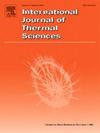A novel spectral emissivity model for rough surfaces applicable beyond geometrical optics region
IF 4.9
2区 工程技术
Q1 ENGINEERING, MECHANICAL
International Journal of Thermal Sciences
Pub Date : 2025-03-25
DOI:10.1016/j.ijthermalsci.2025.109887
引用次数: 0
Abstract
The accurate prediction of emissivity for rough surfaces is critical in fields such as solar thermal energy and radiation thermometry. For practical rough surfaces, directly solving electromagnetic equations is computationally intensive and often lacks analytical solutions. Geometrical optics approximation offers computational efficiency and, in some cases, explicit formulas. However, their applicability is inherently limited, particularly for surfaces with steep slopes or small σ/λ ratios. This paper introduces a formula for calculating a roughness factor based on Gaussian random rough surfaces and presents a concise, wide-range emissivity model that integrates the Finite-Difference Time-Domain (FDTD) method. Results demonstrate that the predicted roughness factor deviates by less than 5 % compared to measurements of sandblasted surfaces, while the derived emissivity values exhibit a maximum relative deviation of less than 3 % from experimental results. In regions where geometrical optics approximation is invalid, emissivity is governed by two dimensionless parameters: σ/τ and σ/λ, within specific ranges. By incorporating an effective roughness factor related to σ/λ into the geometrical optics model, the proposed approach significantly extends the model's applicability. The new model reduces the maximum absolute error compared to FDTD results from 0.43 (using conventional geometrical optics models) to 0.09. This study addresses the limitations of existing emissivity models for rough surfaces where geometrical optics approximation fails, while advancing the understanding of how surface morphology influences emissivity.
粗糙表面的新型光谱发射率模型,适用于几何光学以外的区域
粗糙表面发射率的准确预测在太阳热能和辐射测温等领域至关重要。对于实际的粗糙表面,直接求解电磁方程计算量大,且往往缺乏解析解。几何光学近似提供了计算效率,在某些情况下,还提供了明确的公式。然而,它们的适用性本身是有限的,特别是对于陡坡或小σ/λ比的表面。本文介绍了基于高斯随机粗糙表面的粗糙度因子计算公式,并结合时域有限差分(FDTD)方法,提出了简洁、宽范围的发射率模型。结果表明,与喷砂表面的测量值相比,预测的粗糙度因子偏差小于5%,而导出的发射率值与实验结果的最大相对偏差小于3%。在几何光学近似无效的区域,发射率在特定范围内由两个无量纲参数σ/τ和σ/λ控制。通过在几何光学模型中引入与σ/λ相关的有效粗糙度因子,该方法大大扩展了模型的适用性。与FDTD结果相比,新模型将最大绝对误差从0.43(使用传统几何光学模型)降低到0.09。本研究解决了现有粗糙表面发射率模型的局限性,其中几何光学近似失败,同时促进了对表面形貌如何影响发射率的理解。
本文章由计算机程序翻译,如有差异,请以英文原文为准。
求助全文
约1分钟内获得全文
求助全文
来源期刊

International Journal of Thermal Sciences
工程技术-工程:机械
CiteScore
8.10
自引率
11.10%
发文量
531
审稿时长
55 days
期刊介绍:
The International Journal of Thermal Sciences is a journal devoted to the publication of fundamental studies on the physics of transfer processes in general, with an emphasis on thermal aspects and also applied research on various processes, energy systems and the environment. Articles are published in English and French, and are subject to peer review.
The fundamental subjects considered within the scope of the journal are:
* Heat and relevant mass transfer at all scales (nano, micro and macro) and in all types of material (heterogeneous, composites, biological,...) and fluid flow
* Forced, natural or mixed convection in reactive or non-reactive media
* Single or multi–phase fluid flow with or without phase change
* Near–and far–field radiative heat transfer
* Combined modes of heat transfer in complex systems (for example, plasmas, biological, geological,...)
* Multiscale modelling
The applied research topics include:
* Heat exchangers, heat pipes, cooling processes
* Transport phenomena taking place in industrial processes (chemical, food and agricultural, metallurgical, space and aeronautical, automobile industries)
* Nano–and micro–technology for energy, space, biosystems and devices
* Heat transport analysis in advanced systems
* Impact of energy–related processes on environment, and emerging energy systems
The study of thermophysical properties of materials and fluids, thermal measurement techniques, inverse methods, and the developments of experimental methods are within the scope of the International Journal of Thermal Sciences which also covers the modelling, and numerical methods applied to thermal transfer.
 求助内容:
求助内容: 应助结果提醒方式:
应助结果提醒方式:


